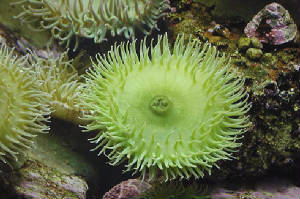|
 |
||||||||||
|
|
|||||||||||
|
The Hydrozoa contain the greatest diversity in the Cnidaria Family. They have medusae, polyps, and surprisingly,
colonies of these organisms bunch together and act like a jellyfish, although it is actually a bunch of organisms, with each
one specializing in a different function. These types are known as "colonial". Some examples of this type of organism are
the Man o' War and By-the-wind-sailors. An exception to the medusa-polyp rule are the freshwater hydrozoans. They spend their life cycle as a polyp, and an example
of this type of life-cycle is most displayed in the organism Medusa. They have special petal discs that allow them to float
on substrates. They also have a special structure that allows them to create air bubbles so they can move around. Colonial hydrozoans have both a medusa and polyp stage, in accordance with the general rule. Most polyps are feeding polyps
which prey upon small crustaceans that blunder into their tentacles. This process continues over and over again until they
create a gonangia. The gonangia acts as a sort of coccoon from which a medusa emerges from later in its life. Once one
has turned into a medusa, it will produce gametes. These produce zygotes if they come in contact with a sufficient amount
and a certain type of substrate. When this is done, they will asexually reproduce, until it develops into a hydroid colony,
thus starting the cycle all over again.
|
|||||||||||
 |
|||||||||||
|
Enter supporting content here This is a student made website for a school project. All pictures are properties of their respective owners. Click on the pictures to link to the website where each picture was found. |
|||||||||||

